
Featured Blog | This community-written post highlights the best of what the game industry has to offer. Read more like it on the Game Developer Blogs or learn how to Submit Your Own Blog Post
The Careful Design of Cave Story
Widely considered a timeless classic in the indie game industry, Doukutsu Monogatari, translated as Cave Story, cemented itself in indie game history as one of the few critically acclaimed games to have been created entirely from scratch by a single perso

The Careful Design of Cave Story
Note: This is a repost of an original article by the author, which can be found here.
Widely considered a timeless classic in the indie game industry, Doukutsu Monogatari, translated as Cave Story, cemented itself in indie game history as one of the few critically acclaimed games to have been created entirely from scratch by a single person, Daisuke Amaya, over the course of 5 years. It was released in 2004 as freeware, and its widespread success catalyzed the meteoric rise of the independent games industry. This article studies various aspects of the game and takes a closer look at the detail and intent put into its careful design.
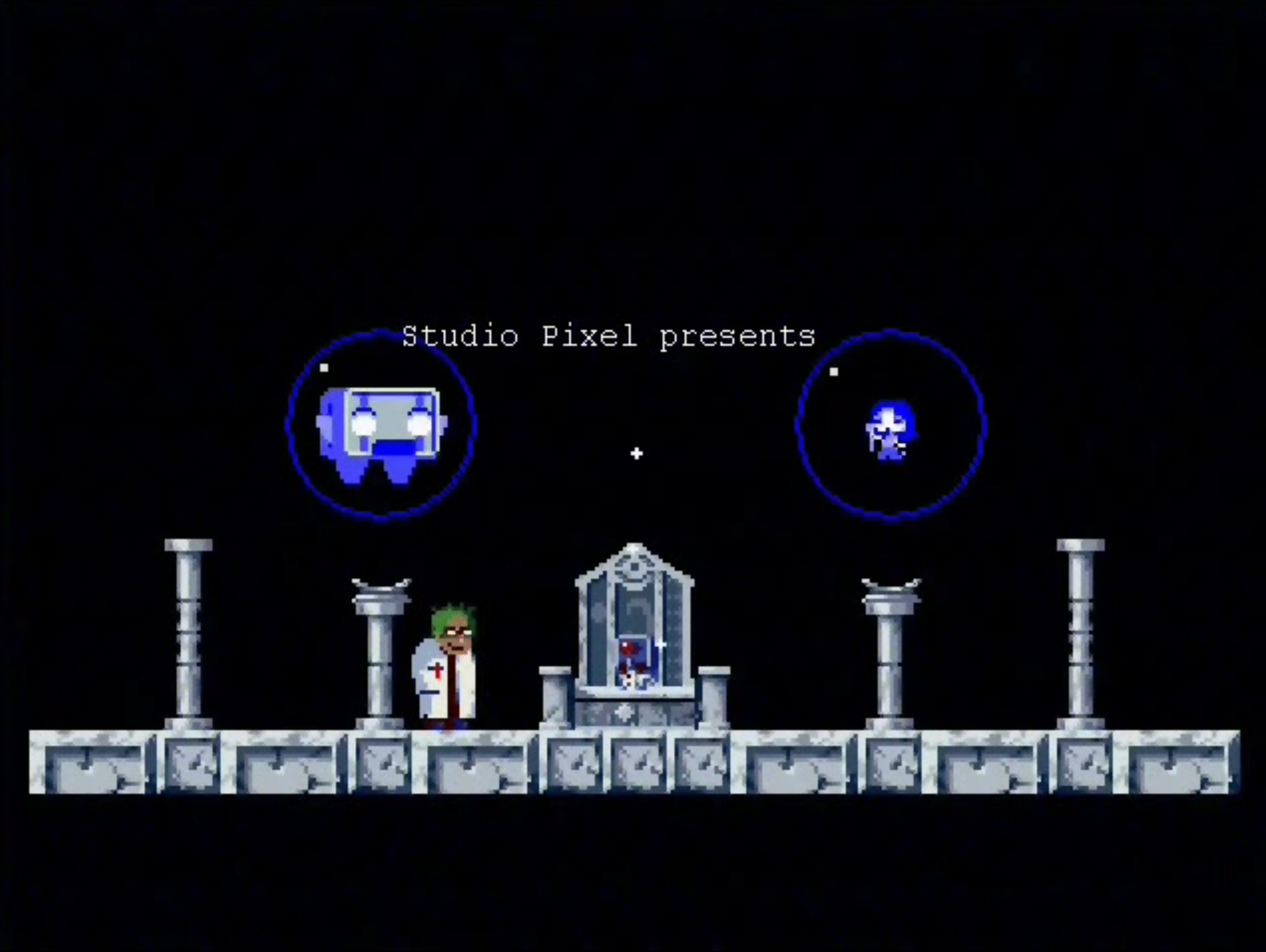
... Cave Story!
For the unfamiliar, Cave Story, released in 2004 by Daisuke Amaya, is a 2D action-adventure shoot-em-up platformer reminiscent of the Super Famicom era of video games. As you venture through the game, you collect upgradeable guns with various properties and platform your way through a series of dungeons and bosses. This short description isn't at all unique to Cave Story, but its seamless storytelling, careful level design, and overall finesse makes Cave Story stand out as a masterfully executed game.
Upon starting the game, you find yourself in a room with no introduction to your character, no explanation of the world, and no hints as to why you're there. You're completely defenseless, so it's lucky that the only thing you see in the room is a small, glimmering pond below you. To the right, a flickering heart machine and a twirling floppy disk glow bright red.
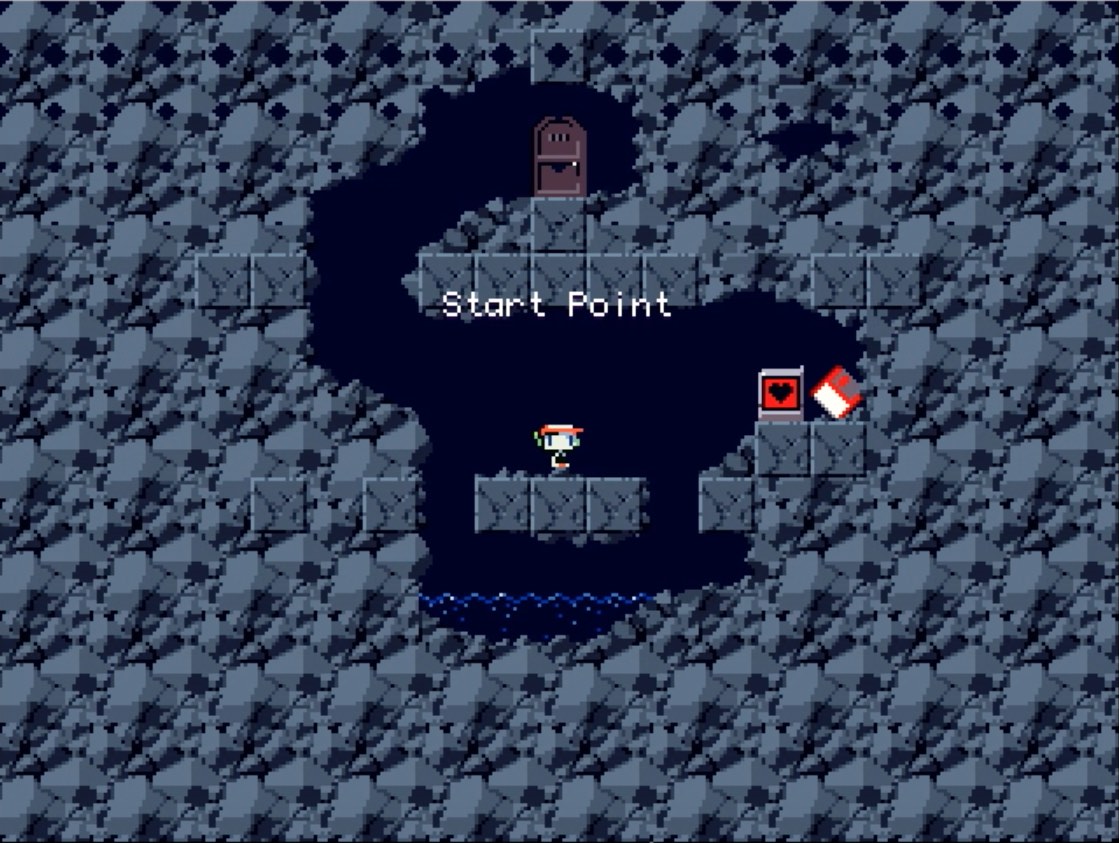
Quite the apt name.
It's often said that some of the best design can be found at the beginning of a game, and Cave Story makes sure that's the case. You easily infer the functions of the distinctive machines, and the lack of enemies lets you familiarize yourself with the button controls at your own pace. You slowly walk left and right, delighted with the subtle visual cues as you look up and down. The starting platform floats quietly, with small gaps on both sides, so you're forced to figure out how to leap across. If you hadn't yet realized that the button for jump was different from that of looking up, you fall down safely. You might stumble into the pond just to see what happens, and find out that it's also harmless - as long as you don't let your breath meter go to zero. Finally, you jump.
If you've played other platformers, the first thing you'll realize is how different Cave Story feels. Though highly reminiscent of classic NES platforming physics, the mechanics of Cave Story are unfamiliar enough to require dramatically new muscle training. Jumping in the air reveals how incredibly buoyant your character is, but your momentum actively works against you, making it surprisingly difficult to change direction in midair and control your character's landing. Then, upon landing, your forward momentum leads to a slippery sensation similar to that of the classic Super Mario Brothers. It's almost as if someone took the floatiness of Samus Aran from Metroid and added the physical inertia of Mario to create a somewhat slow-moving, gun-slinging robot. You suddenly become acutely aware that even when walking, changing direction and overcoming the static friction of inactivity feels a lot slower than you might be used to. You can't even run! It's almost as if the creator intentionally designed it so you wouldn't just blindly rush through the game. Hmm.
Well, when you do finally master the jump, you finish up in the room and make your way outside the door to the rest of the world.


Wow, a reward already?! This game's a piece of cake!
The First Cave starts you off by leading you to the left through a series of bright red spikes, immediately trying to teach you patience with your movement. The first two spikes are easy enough to conquer - as long as you leap after you've passed the ceiling spike, you'll be fine. If you make the mistake of rushing the second pair of spikes, you'll find yourself immediately impaled. The straight clearing located just after you pass the first pair is intentionally angled to position you perfectly to land right onto the leftmost set of floor spikes, and a hasty, instinctive jump launches you into the death trap above. Not only that, your high momentum and slow turn speed does wonders in helping cause accidental deaths and misplaced jumps. This blend of intentionally placed obstacles with the game's patient, deliberate physics helps you naturally accustom to the pacing of the game.
Clearing that short section brings you to your first powerup - the Heart Container! The small capsule blinks its bright red heart invitingly, and picking it up permanently increases your max health by three. As you make your way through the cave, weaving between the bats and dodging the occasional jumper, you finally reach the room with your gun. Well, technically, it's the sleeping gunsmith's... but finder's keepers, right?
You make your way back up the cave, finally able to shoot through the wall blocking the path to the right. You shoot your way through a few fat, leaping balls of fur, and immediately jump towards the door, excited to take on the world with a trusty pistol at your side. As you soar through the air, you suddenly notice something wrong. A single, bright red eye pops open right in the middle of the door, but you can only watch helplessly as your little robot flies into the mimic.
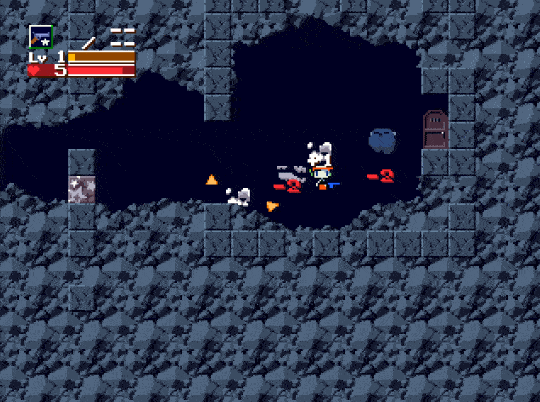
Oh, COME ON.
Suddenly, the early heart container no longer feels out of place. With the four damage taken by the mimic, the game re-emphasizes the importance of patience, and subtly pushes you to be more observant of your surroundings. The more attentive players might've noticed the eye opening and closing as they fought the puff balls, and the more patient players would've seen the red eye appear after clearing the other enemies. The game accomplishes so much with so little, and does so in a fair and harmless way. The heart container you picked up earlier prevents you from being killed in one hit by the door, and even if you were to take damage from the enemies as you fought them, you'd still be left with a single point of health before moving on to the next room. Not only that, by forcing you to start off earlier by going left to grab your gun, getting to this exit requires you to pass by the Starting Point, where you can refill your health and save. Quite helpful in the unfortunate event you do end up overpowered by a door.
As you play through this sequence, the game intersperses a few short cut scenes depicting a green-haired man trapped in an peculiar room. You play through the short scenes, just long enough to pique your interest, but not so lengthy as to bore you. Still not having enlightened you to the extent of your plight, Cave Story teases bits and pieces of its plot to remind you that you're not just a player jumping and shooting enemies. You're a character, venturing forth in an unknown world for unknown reasons, and it's up to you to unravel the story. Cave Story recognizes the importance of narrative, and utilizes this storytelling experience to enhance the game's design while simultaneously guiding you through the mysterious island and its inhabitants.
Warning: In the following section, I go over the overarching premise of the game, briefly describing a small portion of the plot encountered in the first hour or so of gameplay. If you're highly averse to spoilers, or if you're already familiar with the game, you can skip down to the next image. Just know that the story is powerful despite its simplicity, and plays a huge role in the emotional and mechanical depth of the game.

Thankfully, your character doesn't whine or talk this much. Or at all, really.
As you continue to explore the rest of the underground, you come across a desolate town of cute, dog-like creatures called Mimigas. The town's population has been pushed to the brink of extinction, and the few that are left remain scattered and terrified. You find out early on that you are a robot, having somehow ended up underground after having lost your memory, and that a great war between some robots and the inhabitants of the island occurred many years prior to the game. The robots attacked the island, searching for the Demon Crown, a cursed item of great power, killing countless humans and Mimigas in the process. As you play through the story, your relationships with the various characters deepen, and you continue to make friends as you discover your role on the island. You come across all sorts of quirky characters, ranging from talking mushrooms to frog doctors. Some may come to your aid, while others may go so far as to kill you. A few of them merely grant you small, ephemeral moments of serendipitous dialogue as you stumble upon them on, adding to the mystery of the cute little world. Throughout this journey, you make a few key decisions that change the way the story develops, the ending that you get in the game, and even variations on the maps that you see. The overall experience is delivered effectively, and the fact that it was able to do so within such a small game is extraordinary.
Of course, while story is important to a game, at the end of the day, video games are games - not movies - for a reason. Successfully interleaving narrative without detracting from the gameplay experience can be a difficult balance to achieve (not every game thought to use real time narration!). Cave Story employs legitimately fun gameplay with efficient usage of well-designed levels through its storytelling to prevent monotony. You encounter this almost immediately after entering the game, right here in the Mimigas' village.
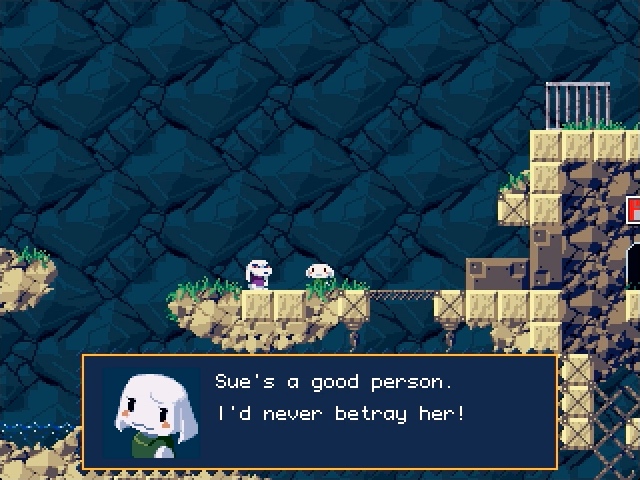
Toroko, the innocent, lovable Mimiga
Upon dropping down on these poor creatures, you're introduced to the first characters in the game, and are then let loose in the village to practice the most basic game mechanics of running and jumping in a danger-free zone. The game's plotline advances the map through a series of explorative fetch quests, and uses the character dialogue to follow the movement of the Toroko, guiding you through the map while simultaneously allowing for open-ended exploration. By the time the subplot ends, you've already been naturally led back and forth through the different areas of the map, and should now be comfortable exploring the rest on your own. Later, in more complex maps, you see a similar usage and reusage of certain areas that might have gone unnoticed the first time passing by. The game employs these tactics to always leave itself open to the player's free will, while continuing to direct them through the game. As an example, reaching the end of the Egg Corridor brings you to the end of a strictly horizontal level, only to lead you backwards again to revisit the eggs located earlier in the map to retrieve a key.

The Egg Corridor: May your eggs be filled with keys.
Those eggs aren't just for decoration! And the platforming? Because of the enemy placement and movement, what was once easy going left to right suddenly becomes difficult to manage when coming back from the other side. Almost every map designs its platforming challenges by taking into account this bidirectional progression of platforming difficulty, each introducing new difficulties to ensure good pacing and game flow. No areas should be left unexplored, and if they are, you may very well be missing a secret or two.
As you run and jump through the enemies, the combat mechanics take cues from classic SNES games like Super Metroid and Castlevania. You collect guns, but instead of collecting upgrades and armor for your character, each gun upgrades with experience dropped by enemies. Every time you take a hit to your life bar, your gun experience simultaneously decreases. Getting hit too often de-levels your gun, often weakening it significantly, so the more damage you take, the more punishing the game becomes. It's an interesting mechanic that truly emphasizes patience when maneuvering the maps. Attempting to brute-force your way through maps not only affects your health and survivability, it also weakens your ability to gain that life back. Combined with the level design, the result is a very tangible feeling of responsibility with your actions - any damage you take is almost always a consequence of impatience or ill planning, and any tough spot you find yourself in is often due to prior mistakes.
The guns themselves also play a big role in the game's variance and replayability. With a total of ten guns in the game, each with three to four upgrades, playstyles can vary widely between different playthroughs. The importance of switching guns is constantly being reiterated through well-designed enemy movements and abilities, and the game takes great care to make sure that you get enough time to learn the effectiveness of each gun. Take the the second gun you get in the game as an example. It's called the Fireball, and its bullets (balls of fire) bounce along the ground instead of going straight. Here's the map that you get it on:
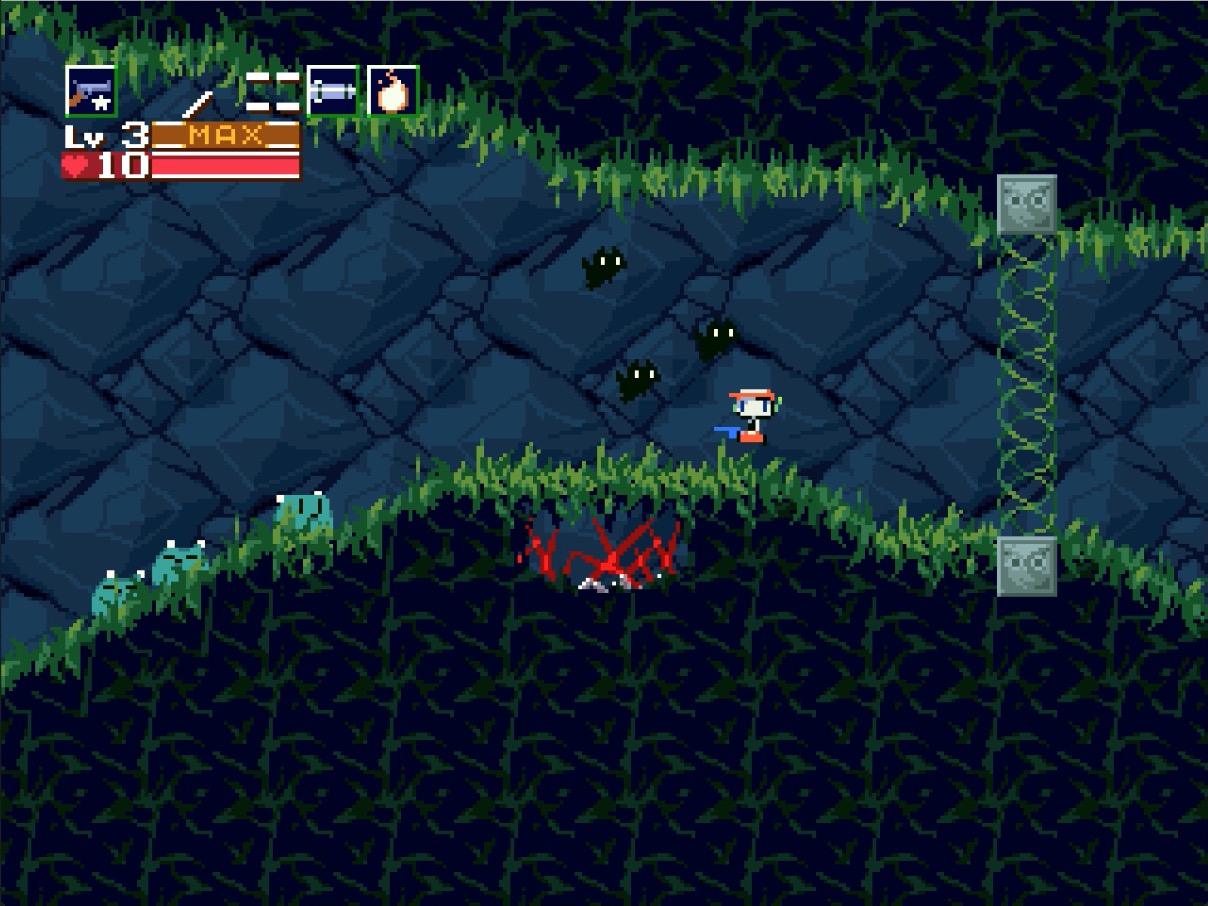
First rule of creature design: the first flying enemies will ALWAYS be bats.
Notice something? Your starting gun, which only shoots in the four cardinal directions, is going to be far less effective on the uneven terrain. Firing at enemies below you suddenly becomes a lot more difficult, something you're forced to experience first hand through a short fetch quest before handing you the Fireball. After receiving the new gun, you realize that its arcing trajectory and slow speed makes it impractical for constant usage. While the cute green monsters on the left become far easier with the Fireball, the same bouncing bullets are far more difficult to land on the dive-bombing bats above you, and a mistimed jump drops you into the spike pit for an instant death. With enemies and obstacles designed to teach you the effectiveness of the guns, the game pushes you to constantly cycle through your arsenal. These preparative sequences are found throughout the game, helping acclimate you to the game mechanics as you progress through the game.
The final part to Cave Story's careful design lies in its fantastic progression of difficulty by using carefully placed visual and mechanical cues. A simple, instinctive example is found through the variety of enemy movement patterns you experience. The more baddies you encounter, the easier they are to deal with and the more comfortable you are to explore the level in its entirety. A few enemies and traps in particular even have distinct visual hints to clue you in, such as this sand crocodile:

Why's there a skull in th- oh.
You encounter a number of these croc traps while running through the sand level, but in case you don't realize the link between the skulls in the sand and those big, snapping, jaws, you come across another, more obvious example. At one point in the game, you're asked to look for and return an old woman's lost puppies, one of which somehow finds his way into a deserted house in the middle of nowhere.
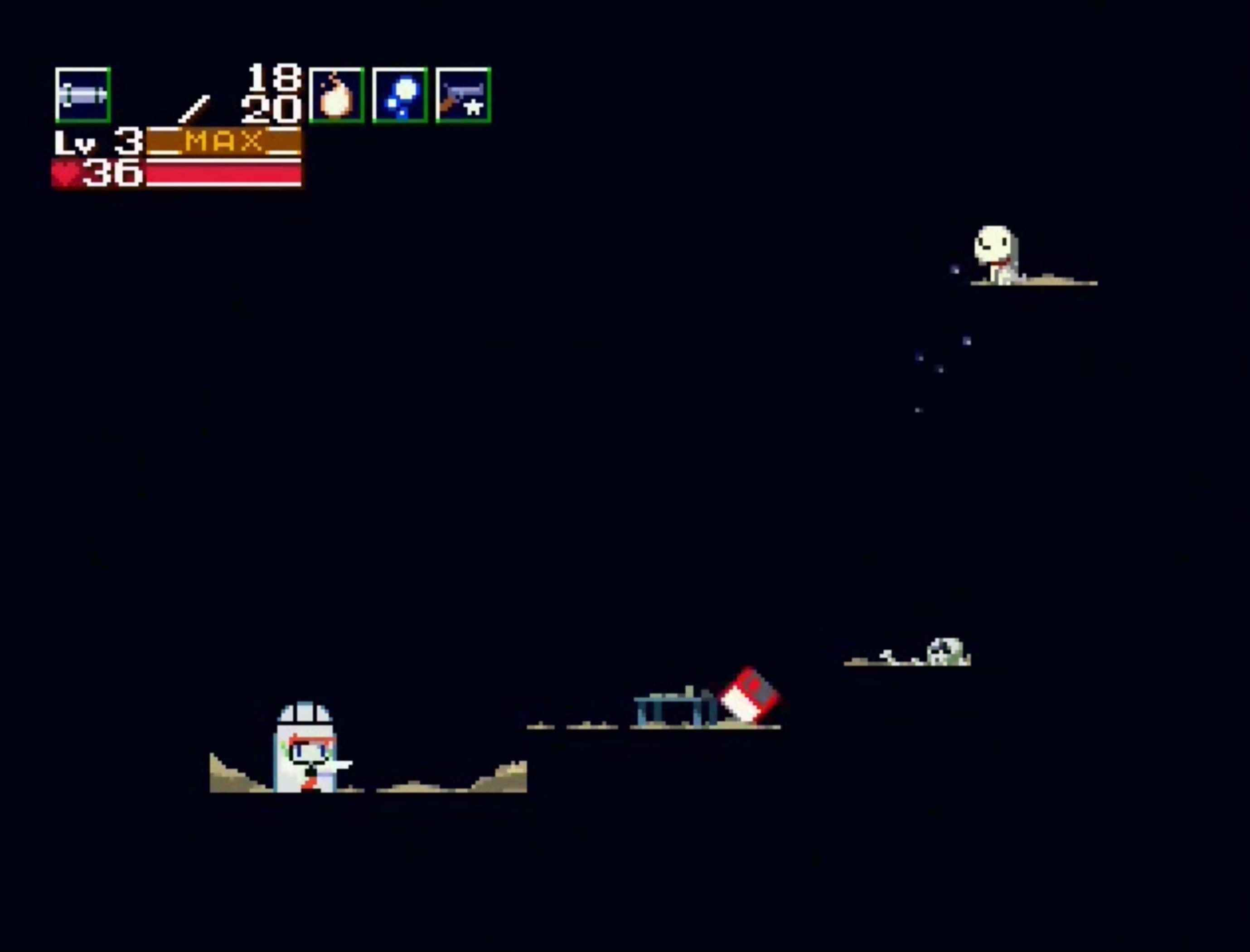
Note to self: buy leash.
As a mandatory yet seemingly unimportant part of the story, this room exemplifies some of subtle but intentional level design you experience without noticing in the larger areas of the game. Despite its simplicity, the room paints a picture of the many deliberate design decisions found throughout the game, and underscores their significance with an unnervingly unique room. The room lacks any distinct visible paths, and the save disk feels jarringly out of place, especially with the absence of the usual health machine accompaniment. The game immediately draws your attention to several items on the screen: the bright red save disk, the skull on an incongruous pit of sand, and the dog with flecks of sand slowly dropping at its feet - the only movement in the room. You instinctively run straight through the sand pit, jumping up towards the dog. You get a bop on the head and drop into the sand pit after hitting an invisible wall blocking your way, and because you weren't given the chance to heal, you more likely than not end up dead. In a very small amount of time, the game reiterates a few subtle points: the visual cue for the crocodile trap, the implication that even within black space things (like secrets!) can exist, and the benefits of saving, no matter your ability. Whether or not you die, you either end up thankful for the disk, or regretful for skipping it in a seemingly innocuous room. In either case, it inherently reinforces the importance of patience and awareness without creating a sense of frustration with the game.
This balance of frustration and difficulty is something inherent in all games. While games like Super Meat Boy and Spelunky thrive on the player's frustration and the satisfaction of dexterous improvement, in Cave Story, you play to uncover the mystery of the world you're in. As such, the game makes sure to prevent the difficulty of the game from getting in the way of the narrative. Though it does ramp up significantly, especially towards the end, the game is generous with its saves and is constantly training and preparing you for the next challenge. Similar to the usage of both directions to familiarize you with each map, several levels are specifically designed with fewer enemies and conveniently located save points to train you on new mechanics and enemies for the subsequent, more difficult dungeons.
But wait, there's more! Daisuke Amaya plays with a lot of really interesting ideas with regards to difficulty and replayability. While most games give you the option to tweak difficulty by selecting between different game modes, this usually just results in arbitrary changes to hit points, drop rates, or damage multipliers. Games like Bastion and Transistor circumvent this by placing dynamic, player-controlled stat changes, but Cave Story predates these methods with another, less intrusive approach. Whereas Bastion gives you more fine-grained control over the game's difficulty, Cave Story changes its difficulty automatically in response to your demonstrated application of everything the game's been continuously training you for, all while remaining transparent to your progression in the story. At one point in the game, your platforming ability, patience, and observance beyond what's put in front of you directly affects the narrative you choose and which one of two items you obtain.

Patience you must have, my not-so-young robot.
The expectation here is that you'll miss the jump, but the game continues to reward everything it's slowly conditioned you to do. To the impatient and unskilled, this deceptively simple jump is just begging to be crossed. The black wire lattice that wraps the path to the door tricks your eyes into thinking the platform reaches farther than it actually does, so a short, sloppy jump will drop you down below. The overhead platform juts out perfectly to deflect a safe landing from above, so a seemingly well-timed jump off the very edge of the platform will just knock you down as well. Any hastily executed leap prevents you from noticing the splotch of red from a conveniently placed save disk on the platform right above you, perfectly covered by your gun level and health bar on the in-game HUD.
Don't start complaining just yet! Notice that the game isn't being unfair, and what might seem like poor UI design is merely a test. The observant player should notice the health machine at the top right, and realize that despite having just come from a horizontal boss battle, this map is oriented vertically. Even the red mark on the ground clues you in to the anomalous situation. The convenient save disk acts as a positive feedback loop and allows for the more persistent player to choose between the more typical path downwards and the more demanding path to the right. Succeeding in the jump delays your reward, forcing you to face future battles without help. This harder, more elusive path not only opens up new possible endings to the game, it completely changes the platform design and enemies in the game's final dungeon! These adjustments are completely invisible to your progression through the game, and purposely stay out of the way of your experience of the story. Even if you're naturally skilled, the game provides you with the difficulty necessary to make the game exciting. If you're still getting the hang of things, the game keeps itself enjoyable while still posing a challenge, without making you feel inadequate.
A similar change of pace can be found even earlier in the game that intentionally addresses the game's replayability. You're given a seemingly innocent choice to permanently exchange your most basic gun for another. On your first playthrough, you'll probably end up doing so - whywouldn't you? Upon doing so, you'll eventually realize that shooting your new Machine Gun downwards floats you up in the air, making platforming suddenly a lot easier.

Look ma, no feet!
But why would anyone want to take platforming, out of a platformer? This counterintuitive design choice places an emphasis on accessible design for all gamers, regardless of your skill. For the new or cautious, the difficulty ramp suddenly becomes a lot less steep. The maps that immediately follow are completely vertical, and your new ability to fly takes you past most of the difficulty. You're given more time to acclimate to the game's physics and combat mechanics, and the handicap gets you through to the most compelling parts of the story, without sacrificing the challenges of the later dungeons in the game. Not only that, if you do end up replaying the game, given the same choice, wouldn't you want to choose differently? The answer to that question is clearly dependent on the player, but the game rewards curiosity. Not only would choosing the alternate path provide a different (and more difficult) experience through the vertical maps - which you should now be well equipped to handle - doing so also opens up the possibility of getting two new weapons previously unavailable to you.
This begs the question - why would you ever replay the game? With most games, replayability comes from gameplay. Roguelikes take advantage of randomization, procedural generation, and permadeath to create unique experiences with each playthrough, and RPG's often employ tricks like NG+ or side quests. While these can be effective in their own right, Cave Story doesn't fit into these molds. Procedural generation and permadeath don't mesh well with narrative driven gameplay for obvious reasons, and Cave Story consists of a small enough world that side quests would just dilute the storytelling. The inclusion of NG+ would make the majority of the game too easy without arbitrarily modifying enemy health or damage. Instead, the story itself does the job of pushing you to question the ending you achieve. Along with a few key decisions you're forced to make, a number of unanswered plot points bring up plenty of questions to be explored. In the end, the game puts its own storytelling forward as a means to compel you to revisit your actions. Are you truly satisfied with the ending you reached?

Spoiler: Yes.
Cave Story is a heartwarming game that shows the incredible amount of thought and care put into its creation. For the romantically inclined, it's a game that I personally consider a visionary embodiment of the ethos of the independent games community. Every aspect was created by a single person working a completely unrelated job. Despite not having any professional background in music, art, writing, or game design, Daisuke Amaya worked on all aspects of Cave Story over the course of 5 years while working his day job, going through multiple iterations and even scrapping the entirety of a "beta" version of the game to start from scratch. It was released as freeware, and its cult-like popularity quickly spread beyond the confines of the scene. Its universal critical acclaim was a testament to the possibility of a single person with sufficient vision and determination to break through an industry dominated by larger studios. Amaya himself earned nothing from the endeavor until nearly 6 years later, when Nicalis Inc. decided to help develop and publish a remastered edition of the game. Since then, several console versions of the game followed, and his celebrated success galvanized the rise of the modern indie games industry.
Cave Story continues to live on as a modern indie classic, and will remain one of the most influential games in my own life. Despite the many games that have come and gone surpassing Cave Story in technical achievement, narrative storytelling, and overall game design, the game's touching story and empowering gameplay, delivered with quaint visuals and absolutely unforgettable music, makes for a truly timeless experience. If this has piqued your interest at all, you can download the original freeware version, or buy the remastered edition by Nicalis, Cave Story+.
Note: I am in no way affiliated with Nicalis, Inc. or Studio Pixel (pffft, as if).
If you're interested in learning even more about the creation of the game, watch Amaya himself speak in his 2011 GDC talk, The Story of CAVE STORY. He talks in great detail regarding the creation of the art, music, and character designs, as well as the history of the game itself. If you enjoyed reading this, follow me on Twitter, like us on Facebook, and subscribe via RSS. You can also find more articles here!
If you're interested in more longform content about Cave Story in video format, you should check out this video. It does a great job further dissecting different aspects of the game this essay doesn't get to, and does so through a thoughtful, well-constructed video. Thanks to Twitter user @2LittleB*stards for sending it to me!
Read more about:
Featured BlogsAbout the Author(s)
You May Also Like







.jpeg?width=700&auto=webp&quality=80&disable=upscale)








